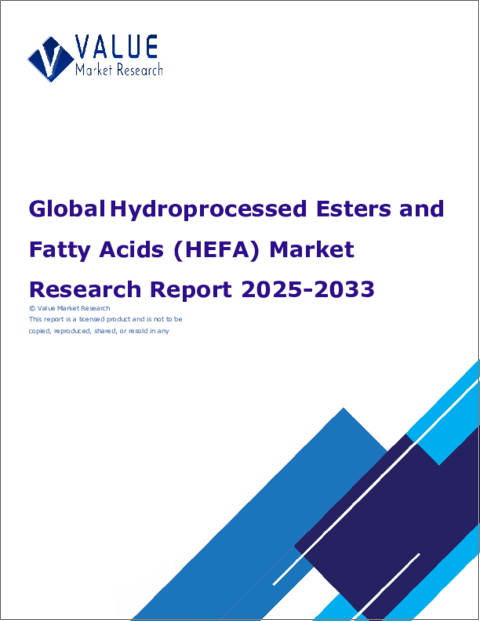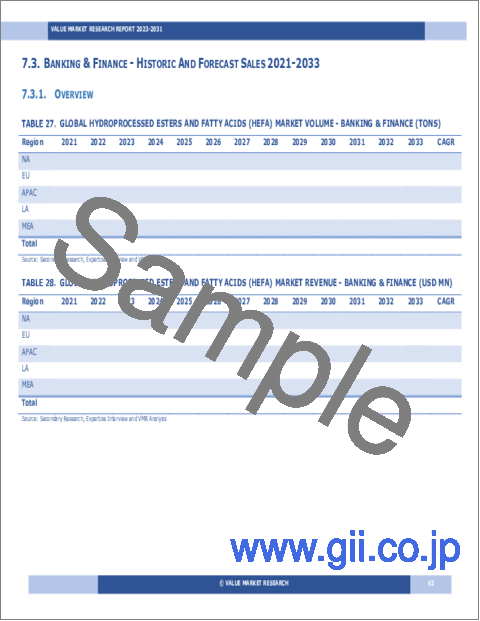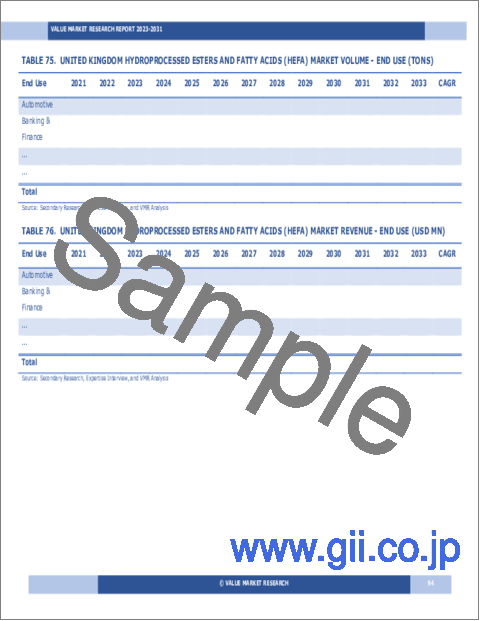|
|
市場調査レポート
商品コード
1683319
水酸化エステル・脂肪酸(HEFA)の世界市場調査レポート:産業分析、規模、シェア、成長、動向、2025年から2033年までの予測Global Hydroprocessed Esters and Fatty Acids (HEFA) Market Research Report- Industry Analysis, Size, Share, Growth, Trends and Forecast 2025 to 2033 |
||||||
カスタマイズ可能
|
|||||||
| 水酸化エステル・脂肪酸(HEFA)の世界市場調査レポート:産業分析、規模、シェア、成長、動向、2025年から2033年までの予測 |
|
出版日: 2025年03月01日
発行: Value Market Research
ページ情報: 英文 198 Pages
納期: 即日から翌営業日
|
全表示
- 概要
- 図表
- 目次
水酸化エステル・脂肪酸(HEFA)の世界市場規模は、2024年の208億8,000万米ドルから2033年には814億6,000万米ドルに成長し、2026~2033年の予測期間中に16.33%の堅調な年間平均成長率(CAGR)を示すと予測されます。
世界の水酸化エステル・脂肪酸(HEFA)市場は、運輸・航空セグメントにおけるサステイナブル再生可能燃料の需要増に牽引され、大幅な成長を遂げる展望です。HEFAは、再生可能な原料から水酸化によって製造され、その結果、従来の化石燃料のドロップイン代替品として使用できる高品質のバイオ燃料が得られます。産業や政府が脱炭素化とよりクリーンなエネルギー源への移行を優先する中、HEFAの採用は大幅に増加し、この市場への技術革新と投資が促進されると予想されます。
さらに、水処理技術と原料の利用可能性の進歩が、HEFA市場をさらに押し上げると予想されます。より効率的な処理方法の開発と、廃棄油脂を含む多様な原料の利用が、HEFA生産の経済性と持続可能性を高めています。さらに、規制遵守と持続可能性認証の重視の高まりが、厳しい環境基準を満たすHEFAソリューションの需要を促進しています。利害関係者が再生可能エネルギー目標達成におけるHEFAの可能性をますます認識するにつれ、水酸化エステル・脂肪酸市場は、多様なエネルギーニーズに応える革新的ソリューションに対する需要の急増を確認する可能性が高いです。
加えて、産業参入企業と規制機関の間の協力にますます焦点が当てられるようになり、HEFA市場の将来が形作られると予想されます。政府が再生可能燃料を促進し、温室効果ガス排出を削減する施策を実施する中、こうした取り組みに合致したHEFAに対する需要は引き続き高まると考えられます。HEFA市場がサステイナブルエネルギーソリューションの最前線であり続けるためには、バイオ燃料生産者、技術開発者、規制機関の間の協力体制が不可欠です。
当社のレポートは、様々な産業や市場に関する包括的かつ実用的な洞察を顧客に提供するために、細心の注意を払って作成されています。各レポートは、市場情勢を完全に理解するために、いくつかの重要な要素を含んでいます。
市場概要:市場概要:定義、分類、産業の現状など、市場に関する詳細なイントロダクション。
市場促進要因:市場成長に影響を与える主要促進要因・抑制要因・市場促進要因・課題を詳細に分析します。このセクションでは、技術の進歩、規制の変更、新たな動向などの要因を検証します。
セグメンテーション分析:製品タイプ、用途、エンドユーザー、地域などの基準に基づき、市場を明確なセグメントに内訳。この分析により、各セグメントの業績と将来性を明らかにします。
競合情勢:市場シェア、製品ポートフォリオ、戦略的イニシアティブ、財務実績など、主要市場参入企業の包括的評価。主要企業が採用する競合力学と主要戦略に関する考察を記載しています。
市場予測:過去のデータと現在の市場状況に基づき、一定期間における市場規模と成長動向を予測。これには、定量的分析と将来の市場軌跡を示すグラフ表示が含まれます。
地域分析:地域による市場パフォーマンスを評価し、主要市場や地域動向を明らかにします。地域の市場力学とビジネス機会を理解するのに役立ちます。
新たな動向と機会:現在の市場動向と新たな市場動向、技術革新、潜在的な投資対象セグメントを特定します。将来の市場開拓と成長展望に関する洞察を記載しています。
目次
第1章 序文
第2章 エグゼクティブサマリー
- 市場のハイライト
- 世界市場スナップショット
第3章 水酸化エステル・脂肪酸(HEFA)産業分析
- イントロダクション-市場力学
- 市場促進要因
- 市場抑制要因
- 機会
- 産業動向
- ポーターのファイブフォース分析
- 市場の魅力分析
第4章 バリューチェーン分析
- バリューチェーン分析
- 原料分析
- 原料リスト
- 原料メーカー一覧
- 主要原料の価格動向
- 潜在的バイヤーリスト
- マーケティングチャネル
- 直接マーケティング
- 間接マーケティング
- マーケティングチャネル発展動向
第5章 水酸化エステル・脂肪酸(HEFA)の世界市場分析:供給源タイプ別
- 供給源タイプ別概要
- 供給源タイプ別過去・予測データ分析
- 植物性油脂
- 動物性油脂
第6章 水酸化エステル・脂肪酸(HEFA)の世界市場分析:用途別
- 用途別概要
- 用途別過去・予測データ分析
- 自動車燃料
- 航空燃料
- 発電機
- 産業用燃料
- その他
第7章 水酸化エステル・脂肪酸(HEFA)の世界市場分析:最終用途別
- 最終用途別概要
- 最終用途別過去・予測データ分析
- 自動車
- 銀行・金融
- 建設
- 軍事
- その他
第8章 水酸化エステル・脂肪酸(HEFA)の世界市場分析:地域別
- 地域別展望
- イントロダクション
- 北米の売上分析
- 概要、実績と予測
- 北米:セグメント別
- 北米:国別
- 米国
- カナダ
- メキシコ
- 欧州売上分析
- 概要、実績と予測
- 欧州:セグメント別
- 欧州:国別
- 英国
- フランス
- ドイツ
- イタリア
- ロシア
- その他の欧州
- アジア太平洋売上分析
- 概要、実績と予測
- アジア太平洋:セグメント別
- アジア太平洋:国別
- 中国
- インド
- 日本
- 韓国
- オーストラリア
- 東南アジア
- その他のアジア太平洋
- ラテンアメリカ売上分析
- 概要、実績と予測
- ラテンアメリカ:セグメント別
- ラテンアメリカ:国別
- ブラジル
- アルゼンチン
- ペルー
- チリ
- その他のラテンアメリカ
- 中東・アフリカ売上分析
- 概要、実績と予測
- 中東・アフリカ:セグメント別
- 中東・アフリカ:国別一覧
- サウジアラビア
- アラブ首長国連邦
- イスラエル
- 南アフリカ
- その他の中東・アフリカ
第9章 水酸化エステル・脂肪酸(HEFA)企業の競合情勢
- 水酸化エステル・脂肪酸(HEFA)市場競合
- パートナーシップ/提携/合意
- 合併・買収
- 新製品上市
- その他の開発
第10章 企業プロファイル
- 上位企業の市場シェア分析
- 市場集中度
- Neste Corporation
- TotalEnergies SE
- Renewable Energy Group Inc.
- Eni S.P.A.
- Chevron Corporation
- BP P.L.C.
- Marathon Petroleum Corporation
- Honeywell UOP
- SABIC(Saudi Basic Industries Corporation)
- Axens
- Galp Energia SGPS S.A
LIST OF TABLES
- Market Snapshot
- Drivers: Impact Analysis
- Restraints: Impact Analysis
- List of Raw Material
- List of Raw Material Manufactures
- Analysis By Source Type (Tons and USD MN)
- Vegetable-sourced Oils Market Sales By Geography (Tons and USD MN)
- Animal-sourced Fats Market Sales By Geography (Tons and USD MN)
- Analysis By Application (Tons and USD MN)
- Vehicle Fuels Market Sales By Geography (Tons and USD MN)
- Aviation Fuels Market Sales By Geography (Tons and USD MN)
- Generators Market Sales By Geography (Tons and USD MN)
- Industrial Market Sales By Geography (Tons and USD MN)
- Others Market Sales By Geography (Tons and USD MN)
- Analysis By End Use (Tons and USD MN)
- Automotive Market Sales By Geography (Tons and USD MN)
- Banking & Finance Market Sales By Geography (Tons and USD MN)
- Construction Market Sales By Geography (Tons and USD MN)
- Military Market Sales By Geography (Tons and USD MN)
- Others Market Sales By Geography (Tons and USD MN)
- Global Hydroprocessed Esters and Fatty Acids (HEFA) Market Sales By Geography (Tons and USD MN)
- North America Market Analysis (Tons and USD MN)
- United States Market Analysis (Tons and USD MN)
- Canada Market Analysis (Tons and USD MN)
- Mexico Market Analysis (Tons and USD MN)
- Europe Market Analysis (Tons and USD MN)
- Europe Market Estimate By Country (Tons and USD MN)
- United Kingdom Market Analysis (Tons and USD MN)
- France Market Analysis (Tons and USD MN)
- Germany Market Analysis (Tons and USD MN)
- Italy Market Analysis (Tons and USD MN)
- Russia Market Analysis (Tons and USD MN)
- Spain Market Analysis (Tons and USD MN)
- Rest of Europe Market Analysis (Tons and USD MN)
- Asia Pacific Market Analysis (Tons and USD MN)
- China Market Analysis (Tons and USD MN)
- Japan Market Analysis (Tons and USD MN)
- India Market Analysis (Tons and USD MN)
- South Korea Market Analysis (Tons and USD MN)
- Australia Market Analysis (Tons and USD MN)
- South East Asia Market Analysis (Tons and USD MN)
- Rest of Asia Pacific Market Analysis (Tons and USD MN)
- Latin America Market Analysis (Tons and USD MN)
- Brazil Market Analysis (Tons and USD MN)
- Argentina Market Analysis (Tons and USD MN)
- Peru Market Analysis (Tons and USD MN)
- Chile Market Analysis (Tons and USD MN)
- Rest of Latin America Market Analysis (Tons and USD MN)
- Middle East & Africa Market Analysis (Tons and USD MN)
- Saudi Arabia Market Analysis (Tons and USD MN)
- UAE Market Analysis (Tons and USD MN)
- Israel Market Analysis (Tons and USD MN)
- South Africa Market Analysis (Tons and USD MN)
- Rest of Middle East and Africa Market Analysis (Tons and USD MN)
- Partnership/Collaboration/Agreement
- Mergers And Acquisition
LIST OF FIGURES
- Research Scope of Hydroprocessed Esters and Fatty Acids (HEFA) Report
- Market Research Process
- Market Research Methodology
- Global Hydroprocessed Esters and Fatty Acids (HEFA) Market Size, By Region (Tons and USD MN)
- Porters Five Forces Analysis
- Market Attractiveness Analysis By Source Type
- Market Attractiveness Analysis By Application
- Market Attractiveness Analysis By End Use
- Market Attractiveness Analysis By Region
- Value Chain Analysis
- Global Market Analysis By Source Type (Tons and USD MN)
- Vegetable-sourced Oils Market Sales By Geography (Tons and USD MN)
- Animal-sourced Fats Market Sales By Geography (Tons and USD MN)
- Global Market Analysis By Application (Tons and USD MN)
- Vehicle Fuels Market Sales By Geography (Tons and USD MN)
- Aviation Fuels Market Sales By Geography (Tons and USD MN)
- Generators Market Sales By Geography (Tons and USD MN)
- Industrial Market Sales By Geography (Tons and USD MN)
- Others Market Sales By Geography (Tons and USD MN)
- Global Market Analysis By End Use (Tons and USD MN)
- Automotive Market Sales By Geography (Tons and USD MN)
- Banking & Finance Market Sales By Geography (Tons and USD MN)
- Construction Market Sales By Geography (Tons and USD MN)
- Military Market Sales By Geography (Tons and USD MN)
- Others Market Sales By Geography (Tons and USD MN)
- Global Market Sales (Tons and USD MN)
- North America Market Sales (Tons and USD MN)
- Europe Market Sales (Tons and USD MN)
- Asia Pacific Market Sales (Tons and USD MN)
- Latin America Market Sales (Tons and USD MN)
- Middle East & Africa Market Sales (Tons and USD MN)
- Recent Development in Industry
- Top Company Market Share Analysis
Kindly note that the above listed are the basic tables and figures of the report and are not limited to the TOC.
Global Hydroprocessed Esters and Fatty Acids (HEFA) Market size is anticipated to grow from USD 20.88 Billion in 2024 to USD 81.46 Billion by 2033, showcasing a robust Compound Annual Growth Rate (CAGR) of 16.33% during the forecast period of 2026 to 2033.
The global hydroprocessed esters and fatty acids (HEFA) market is set to experience substantial growth, driven by the increasing demand for sustainable and renewable fuels in the transportation and aviation sectors. HEFA is produced from renewable feedstocks through hydroprocessing, resulting in high-quality biofuels that can be used as drop-in replacements for conventional fossil fuels. As industries and governments prioritize decarbonization and the transition to cleaner energy sources, the adoption of HEFA is expected to rise significantly, fostering innovation and investment in this market.
Moreover, advancements in hydroprocessing technologies and feedstock availability are anticipated to further boost the HEFA market. The development of more efficient processing methods and the utilization of diverse feedstocks, including waste oils and fats, are enhancing the economic viability and sustainability of HEFA production. Additionally, the growing emphasis on regulatory compliance and sustainability certifications is driving the demand for HEFA solutions that meet stringent environmental standards. As stakeholders increasingly recognize the potential of HEFA in achieving renewable energy goals, the market for hydroprocessed esters and fatty acids is likely to witness a surge in demand for innovative solutions that cater to diverse energy needs.
In addition, the increasing focus on collaboration between industry players and regulatory agencies is expected to shape the future of the HEFA market. As governments implement policies to promote renewable fuels and reduce greenhouse gas emissions, the demand for HEFA that aligns with these initiatives will continue to rise. Collaborative efforts between biofuel producers, technology developers, and regulatory bodies will be essential in driving these advancements, ensuring that the HEFA market remains at the forefront of sustainable energy solutions.
Our reports are meticulously crafted to provide clients with comprehensive and actionable insights into various industries and markets. Each report encompasses several critical components to ensure a thorough understanding of the market landscape:
Market Overview: A detailed introduction to the market, including definitions, classifications, and an overview of the industry's current state.
Market Dynamics: In-depth analysis of key drivers, restraints, opportunities, and challenges influencing market growth. This section examines factors such as technological advancements, regulatory changes, and emerging trends.
Segmentation Analysis: Breakdown of the market into distinct segments based on criteria like product type, application, end-user, and geography. This analysis highlights the performance and potential of each segment.
Competitive Landscape: Comprehensive assessment of major market players, including their market share, product portfolio, strategic initiatives, and financial performance. This section provides insights into the competitive dynamics and key strategies adopted by leading companies.
Market Forecast: Projections of market size and growth trends over a specified period, based on historical data and current market conditions. This includes quantitative analyses and graphical representations to illustrate future market trajectories.
Regional Analysis: Evaluation of market performance across different geographical regions, identifying key markets and regional trends. This helps in understanding regional market dynamics and opportunities.
Emerging Trends and Opportunities: Identification of current and emerging market trends, technological innovations, and potential areas for investment. This section offers insights into future market developments and growth prospects.
SEGMENTATION COVERED IN THE REPORT
By Source Type
- Vegetable-sourced Oils
- Animal-sourced Fats
By Application
- Vehicle Fuels
- Aviation Fuels
- Generators
- Industrial
- Others
By End Use
- Automotive
- Banking & Finance
- Construction
- Military
- Others
- COMPANIES PROFILED
- Neste Corporation
- TotalEnergies SE
- Renewable Energy Group Inc.
- Eni S.p.A.
- Chevron Corporation
- BP p.l.c.
- Marathon Petroleum Corporation
- Honeywell UOP
- SABIC (Saudi Basic Industries Corporation)
- Axens
- Galp Energia SGPS S.A.
- The above list can be customized.
TABLE OF CONTENTS
1. PREFACE
- 1.1. Report Description
- 1.1.1 Objective
- 1.1.2 Target Audience
- 1.1.3 Unique Selling Proposition (USP) & offerings
- 1.2. Research Scope
- 1.3. Research Methodology
- 1.3.1 Market Research Process
- 1.3.2 Market Research Methodology
2. EXECUTIVE SUMMARY
- 2.1. Highlights of Market
- 2.2. Global Market Snapshot
3. HYDROPROCESSED ESTERS AND FATTY ACIDS (HEFA) INDUSTRY ANALYSIS
- 3.1. Introduction - Market Dynamics
- 3.2. Market Drivers
- 3.3. Market Restraints
- 3.4. Opportunities
- 3.5. Industry Trends
- 3.6. Porter's Five Force Analysis
- 3.7. Market Attractiveness Analysis
- 3.7.1 Market Attractiveness Analysis By Source Type
- 3.7.2 Market Attractiveness Analysis By Application
- 3.7.3 Market Attractiveness Analysis By End Use
- 3.7.4 Market Attractiveness Analysis By Region
4. VALUE CHAIN ANALYSIS
- 4.1. Value Chain Analysis
- 4.2. Raw Material Analysis
- 4.2.1 List of Raw Materials
- 4.2.2 Raw Material Manufactures List
- 4.2.3 Price Trend of Key Raw Materials
- 4.3. List of Potential Buyers
- 4.4. Marketing Channel
- 4.4.1 Direct Marketing
- 4.4.2 Indirect Marketing
- 4.4.3 Marketing Channel Development Trend
5. GLOBAL HYDROPROCESSED ESTERS AND FATTY ACIDS (HEFA) MARKET ANALYSIS BY SOURCE TYPE
- 5.1. Overview By Source Type
- 5.2. Historical and Forecast Data Analysis By Source Type
- 5.3. Vegetable-sourced Oils Historic and Forecast Sales By Regions
- 5.4. Animal-sourced Fats Historic and Forecast Sales By Regions
6. GLOBAL HYDROPROCESSED ESTERS AND FATTY ACIDS (HEFA) MARKET ANALYSIS BY APPLICATION
- 6.1. Overview By Application
- 6.2. Historical and Forecast Data Analysis By Application
- 6.3. Vehicle Fuels Historic and Forecast Sales By Regions
- 6.4. Aviation Fuels Historic and Forecast Sales By Regions
- 6.5. Generators Historic and Forecast Sales By Regions
- 6.6. Industrial Historic and Forecast Sales By Regions
- 6.7. Others Historic and Forecast Sales By Regions
7. GLOBAL HYDROPROCESSED ESTERS AND FATTY ACIDS (HEFA) MARKET ANALYSIS BY END USE
- 7.1. Overview By End Use
- 7.2. Historical and Forecast Data Analysis By End Use
- 7.3. Automotive Historic and Forecast Sales By Regions
- 7.4. Banking & Finance Historic and Forecast Sales By Regions
- 7.5. Construction Historic and Forecast Sales By Regions
- 7.6. Military Historic and Forecast Sales By Regions
- 7.7. Others Historic and Forecast Sales By Regions
8. GLOBAL HYDROPROCESSED ESTERS AND FATTY ACIDS (HEFA) MARKET ANALYSIS BY GEOGRAPHY
- 8.1. Regional Outlook
- 8.2. Introduction
- 8.3. North America Sales Analysis
- 8.3.1 Overview, Historic and Forecast Data Sales Analysis
- 8.3.2 North America By Segment Sales Analysis
- 8.3.3 North America By Country Sales Analysis
- 8.3.4 United States Sales Analysis
- 8.3.5 Canada Sales Analysis
- 8.3.6 Mexico Sales Analysis
- 8.4. Europe Sales Analysis
- 8.4.1 Overview, Historic and Forecast Data Sales Analysis
- 8.4.2 Europe By Segment Sales Analysis
- 8.4.3 Europe By Country Sales Analysis
- 8.4.4 United Kingdom Sales Analysis
- 8.4.5 France Sales Analysis
- 8.4.6 Germany Sales Analysis
- 8.4.7 Italy Sales Analysis
- 8.4.8 Russia Sales Analysis
- 8.4.9 Rest Of Europe Sales Analysis
- 8.5. Asia Pacific Sales Analysis
- 8.5.1 Overview, Historic and Forecast Data Sales Analysis
- 8.5.2 Asia Pacific By Segment Sales Analysis
- 8.5.3 Asia Pacific By Country Sales Analysis
- 8.5.4 China Sales Analysis
- 8.5.5 India Sales Analysis
- 8.5.6 Japan Sales Analysis
- 8.5.7 South Korea Sales Analysis
- 8.5.8 Australia Sales Analysis
- 8.5.9 South East Asia Sales Analysis
- 8.5.10 Rest Of Asia Pacific Sales Analysis
- 8.6. Latin America Sales Analysis
- 8.6.1 Overview, Historic and Forecast Data Sales Analysis
- 8.6.2 Latin America By Segment Sales Analysis
- 8.6.3 Latin America By Country Sales Analysis
- 8.6.4 Brazil Sales Analysis
- 8.6.5 Argentina Sales Analysis
- 8.6.6 Peru Sales Analysis
- 8.6.7 Chile Sales Analysis
- 8.6.8 Rest of Latin America Sales Analysis
- 8.7. Middle East & Africa Sales Analysis
- 8.7.1 Overview, Historic and Forecast Data Sales Analysis
- 8.7.2 Middle East & Africa By Segment Sales Analysis
- 8.7.3 Middle East & Africa By Country Sales Analysis
- 8.7.4 Saudi Arabia Sales Analysis
- 8.7.5 UAE Sales Analysis
- 8.7.6 Israel Sales Analysis
- 8.7.7 South Africa Sales Analysis
- 8.7.8 Rest Of Middle East And Africa Sales Analysis
9. COMPETITIVE LANDSCAPE OF THE HYDROPROCESSED ESTERS AND FATTY ACIDS (HEFA) COMPANIES
- 9.1. Hydroprocessed Esters and Fatty Acids (HEFA) Market Competition
- 9.2. Partnership/Collaboration/Agreement
- 9.3. Merger And Acquisitions
- 9.4. New Product Launch
- 9.5. Other Developments
10. COMPANY PROFILES OF HYDROPROCESSED ESTERS AND FATTY ACIDS (HEFA) INDUSTRY
- 10.1. Top Companies Market Share Analysis
- 10.2. Market Concentration Rate
- 10.3. Neste Corporation
- 10.3.1 Company Overview
- 10.3.2 Company Revenue
- 10.3.3 Products
- 10.3.4 Recent Developments
- 10.4. TotalEnergies SE
- 10.4.1 Company Overview
- 10.4.2 Company Revenue
- 10.4.3 Products
- 10.4.4 Recent Developments
- 10.5. Renewable Energy Group Inc.
- 10.5.1 Company Overview
- 10.5.2 Company Revenue
- 10.5.3 Products
- 10.5.4 Recent Developments
- 10.6. Eni S.P.A.
- 10.6.1 Company Overview
- 10.6.2 Company Revenue
- 10.6.3 Products
- 10.6.4 Recent Developments
- 10.7. Chevron Corporation
- 10.7.1 Company Overview
- 10.7.2 Company Revenue
- 10.7.3 Products
- 10.7.4 Recent Developments
- 10.8. BP P.L.C.
- 10.8.1 Company Overview
- 10.8.2 Company Revenue
- 10.8.3 Products
- 10.8.4 Recent Developments
- 10.9. Marathon Petroleum Corporation
- 10.9.1 Company Overview
- 10.9.2 Company Revenue
- 10.9.3 Products
- 10.9.4 Recent Developments
- 10.10. Honeywell UOP
- 10.10.1 Company Overview
- 10.10.2 Company Revenue
- 10.10.3 Products
- 10.10.4 Recent Developments
- 10.11. SABIC (Saudi Basic Industries Corporation)
- 10.11.1 Company Overview
- 10.11.2 Company Revenue
- 10.11.3 Products
- 10.11.4 Recent Developments
- 10.12. Axens
- 10.12.1 Company Overview
- 10.12.2 Company Revenue
- 10.12.3 Products
- 10.12.4 Recent Developments
- 10.13. Galp Energia SGPS S.A
- 10.13.1 Company Overview
- 10.13.2 Company Revenue
- 10.13.3 Products
- 10.13.4 Recent Developments






